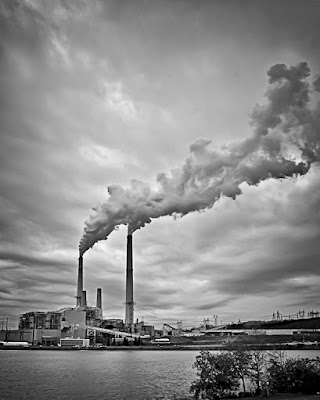 Let's dispense with the obvious, if you don't have Adobe Photoshop Lightroom 3 you can do a Black & White image completely in Adobe Photoshop CS5. After all, Adobe Camera Raw (ACR), which comes with Photoshop, has the same engine as the Develop Module in LR3. So, bouncing back and forth from LR3 to CS5 and back a few times is more a matter of personal workflow. Today's image started out as a five image HDR mashup. It's not an "over the top" HDR, but a pretty subtle form of the technique. I can go either way with HDR, but tend to be more interested in the photorealistic side. A buddy of mine (that would be you Lorri) is a great practitioner of the far side of HDR. Her HDR images are beautiful. Take a look at her portfolio. She tends to push to the illustrative side and I'll have to sit down with her one of these days and take a lesson on her technique. The question today comes from several search queries that brought people to the gallery this past week. Hopefully I can "focus" a little light on the subject. (I know, bad pun.) Today's image is straight out of LR3/CS5. I played with the two week trial of Nik Software's Silver Effects Pro 2, and thought it was a very interesting piece of software. I'm old enough to have come from B&W film developing and printing, so I think I might have a bit of an advantage over those who have never done wet printing. Don't get me wrong, I'm glad those days are gone and I sit in front of a computer to do my "darkroom" work . To get an idea of how to apply wet darkroom techniques in a dry darkroom, hit the "Read More".
Let's dispense with the obvious, if you don't have Adobe Photoshop Lightroom 3 you can do a Black & White image completely in Adobe Photoshop CS5. After all, Adobe Camera Raw (ACR), which comes with Photoshop, has the same engine as the Develop Module in LR3. So, bouncing back and forth from LR3 to CS5 and back a few times is more a matter of personal workflow. Today's image started out as a five image HDR mashup. It's not an "over the top" HDR, but a pretty subtle form of the technique. I can go either way with HDR, but tend to be more interested in the photorealistic side. A buddy of mine (that would be you Lorri) is a great practitioner of the far side of HDR. Her HDR images are beautiful. Take a look at her portfolio. She tends to push to the illustrative side and I'll have to sit down with her one of these days and take a lesson on her technique. The question today comes from several search queries that brought people to the gallery this past week. Hopefully I can "focus" a little light on the subject. (I know, bad pun.) Today's image is straight out of LR3/CS5. I played with the two week trial of Nik Software's Silver Effects Pro 2, and thought it was a very interesting piece of software. I'm old enough to have come from B&W film developing and printing, so I think I might have a bit of an advantage over those who have never done wet printing. Don't get me wrong, I'm glad those days are gone and I sit in front of a computer to do my "darkroom" work . To get an idea of how to apply wet darkroom techniques in a dry darkroom, hit the "Read More"."Back in the old days" you'd develop your film, let it dry and then start "reading" your negatives. Today you come back from doing a shoot and upload images to the computer. "Then" you looked at the contrast of the negative and took a SWAG (Scientific Wild Ass Guess) at what paper grade you think might be close. "Now" you go to the camera presets to get a starting point for finishing your image. "Then" you'd make a test print to see 1. if you were close on the paper grade and 2. to see where you needed to do some work. "Now", if you have LR3 you can slide your cursor down through the LR3 Presets found in the Develop Module. If Adobe hasn't given you enough choices you can find hundreds of presets by doing a Google search. Presets shouldn't be thought of as the end of the development process, but as the beginning of the process. If you just happen to find one and can say "that's it", that's fine, but, just like in the wet darkroom, you'll probably see some areas that need tweaking.
In the wet darkroom you'd do some selective Dodging and Burning. You'll do the same thing in a dry darkroom, except you have a lot more tools to play with. "Then" you might go through several sheets of paper (at a buck and a half back in the 70s). Expose the image, Dodging in the areas you feel need to be held back. Either continue the exposure and Burn the areas or restart the exposure for each Burn area. Meticulous note taking was a must in the wet darkroom. You'd probably use a red marker to make notes on your test print as remind you where you wanted to do what. A 16 x 20 print might be filled with ten or fifteen circles of red indicating this or that adjustment. In the case of Burning a circle might have a cryptic +2 in it. Meaning I (everyone had their own methods) wanted to Burn that area twice as long (one stop) as the overall exposure. "Now" you can do test after test and the changes are "sticky". In the wet darkroom you had to repeat all the adjustments on the next try. Today when you get one area just the way you like it you leave it alone, go on to the next area needing a tweak.
Life is good in the Dry Darkroom. No smells, no waste paper basket full of test prints, no needing to get to the finished print before passing out from lack of sleep. It doesn't matter if you do the entire process in Lightroom, in Photoshop or bounce back and forth using the best parts of each program. The Dry Darkroom is better.





0 comments:
Post a Comment